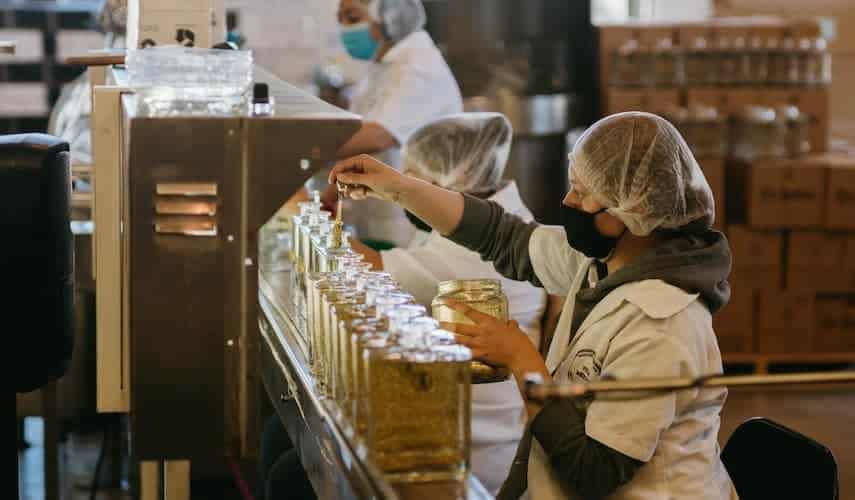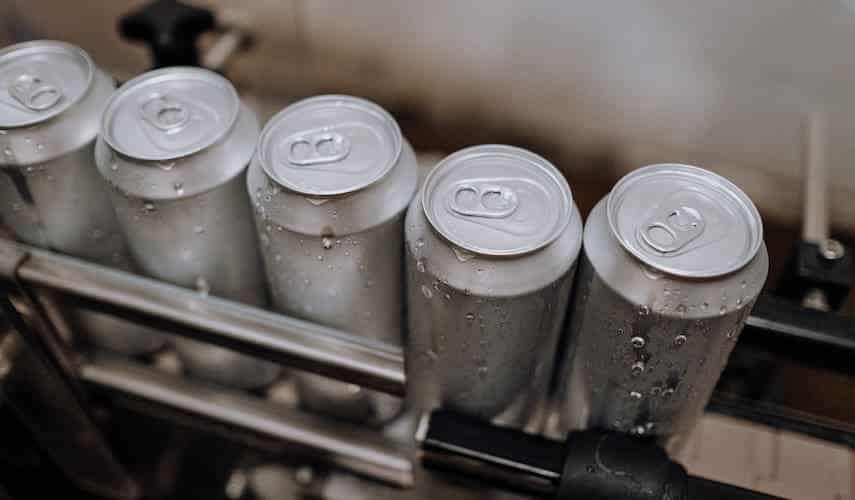
Rising energy, labour, and material cost are increasing the cost of production and cutting into profit margins. Manufacturing operations need to implement effective production management tools and processes to reduce the cost of producing goods.
This article explains the importance of production management, the key processes, and tools you can implement to minimise the cost of inputs while maximising productivity and quality.
What is production management?
Production management is the process that oversees the activities undertaken throughout the progression of converting your production inputs – such as raw materials, human resources, and other assets – into finished goods. It involves the planning, coordination, monitoring, and administration of your production processes.
Production management aims to monitor and improve your manufacturing performance. It helps to ensure the resources necessary for producing your goods are being managed efficiently, and that you’re meeting the essential quality and quantity expectations.
Different disciplines are required to facilitate efficient production management processes including scheduling, planning, process improvement, production inventory management, and quality control.
The difference between production and operations management
The terms production and operations management are often used interchangeably and assumed to be the same thing. However, production management handles the activities related to production while operation management is a broader approach that manages the admin and business operations associated with manufacturing.
Production management is a division of operations management. If you fail to manage production then your overall operations management will not succeed. Likewise, by lifting production efficiency you can simultaneously improve the efficiency of your entire business.

The importance of production management in manufacturing
Production management in manufacturing is vital. When it’s designed and implemented correctly, it helps manufacturers control costs, increase profit margins, and improve the bottom line.
The purpose of production management is to create efficient processes, minimise the cost of manufacturing, and ensure production capacity is fully utilised.
Five important benefits of production management include:
- It reduces the cost of production and manufacturing costs
- It optimises the use of manufacturing resources
- It improves production cycle time and on-time delivery
- It helps to deliver goods of the right quality and right quantity, on time and within budget.
Lastly, production management is essential for safeguarding against costly inefficiencies and enables manufacturers to minimise costs while maximising profits.
Understanding the production management process
“The key to successful production management lies in embracing technological solutions, investing in employee training, and fostering clear communication channels to ensure both efficiency and quality are maintained.”
– Daniel Chabert, CEO & Founder of PurpleFire
The production management process involves can be broken down into five stages:
- Planning
- Scheduling
- Control
- Equipment maintenance and repairs
- Inventory management
Let’s explore these processes in more detail.
1. Production planning
Production planning is the initial stage of the production management process. It involves deciding where, when, and how production will ensue.
Planning outlines the step-by-step process of producing your product from start to finish. It creates a process map to help identify the raw materials needed to produce a product and guides production schedules and the allocation of resources.
A production plan should also inform the amount of goods to produce and specify a deadline for production.
2. Production control
Production control is the decision-making phase of production management. It focuses on managing day-to-day operations, scheduling production runs, and controlling quality and costs. Here you are monitoring the production process to ensure that it follows the plan and meets the objectives of the plan.
Controlling production revolves around many variables such as raw materials, machinery and equipment, your workforce, and workflows. Production control ensures that your production team can achieve the expected target with efficient use of resources.
3. Production scheduling
Production scheduling is the forecast and planning of when products will be manufactured. Scheduling aims to avoid stockouts while maximising manufacturing efficiency.
An effective production schedule will help you:
- Organise your employees and ensure they have the necessary skills and training.
- Estimate budgets for parts and labour.
- Eliminate potential workflow disruptions.
- Maintain par levels of raw materials and inventory stock used to produce your goods.
- Implement contingencies in times of changing supply and demand.
- Monitor processes, improve efficiency, and identify opportunities for improvement.
- Improve visibility across manufacturing dashboards.
Production schedules are dynamic documents that may include certain variances relevant to the current production cycle. A successful production schedule should be supported by key manufacturing performance indicators.

4. Equipment maintenance and repairs
Managing the maintenance and repairs of machinery and equipment is an important function of any production system. Equipment and maintenance repairs are those tasks necessary to maintain your company’s assets while managing both time and costs.
The role of your plant maintenance team is to ensure that your manufacturing processes are operating at maximum efficiency. Working to keep all production assets in good working condition to reduce any lost time due to production stoppage.
Equipment maintenance generally falls into three categories: Reactive, Preventative, and Predicative.
1. Breakdown or reactive maintenance
Reactive maintenance is undertaken after an equipment failure or when your machinery is showing signs of damage. This is an old-school approach to maintenance and has been around for a long time. Reactive maintenance is only performed after a production asset has broken down, with the focus on restoring it to operating conditions as fast as possible.
2. Preventative maintenance
Preventative maintenance involves the regular servicing of machinery and equipment required for production. It’s where your maintenance team anticipates what is most likely to wear or break down. It also requires a level of production inventory management to ensure that the spare parts needed for maintenance tasks are on hand when needed.
3. Predictive maintenance
Predictive maintenance uses a variety of technologies – such as artificial intelligence, machine learning, and the Internet of Things – to gather data from your machinery and equipment. According to McKinsey, predictive maintenance typically reduces machine downtime by 30–50% while increasing machine life by 20–40%.
Predictive maintenance technology gathers data from your connected resources to secure valuable information on the current condition of your machinery and equipment. This information is then delivered to your maintenance team.
5. Production inventory management
“Production managers must adapt to changes in market demand, supply chain fluctuations, and advancements in technology, all while keeping the workforce motivated and skilled. A reliable inventory management software should be the top priority for any business.”
– Ryan Mckenzie, Co-Founder & CMO of Tru Earth
Production inventory management is crucial to ensuring you have sufficient stock on hand for your manufacturing processes. Effectively managing your production inventory means you can control inventory levels to avoid production downtime and meet your customer demand.
Inventory management software helps you to optimise production operations with accurate real-time visibility of inventory levels to prevent inventory over-stocking or understocking of goods.
Production process improvement
Production process improvement is a team approach to evaluating the current processes of your team and revising them as necessary. Production process improvement techniques aim to increase productivity, streamline workflows, and increase profitability.
Process improvement in manufacturing operations seeks to optimise the many workflow and production tasks to efficiently improve productivity while also reducing costs and limiting waste.
Seven of the best production process improvement methodologies your team can employ are:
- Six Sigma
- Kaizen
- Lean manufacturing
- PDCA cycle
- The 5 whys
- Business process management
- 5S process improvement
We explore each of these in detail below.
Six Sigma
Six Sigma is a technique used in manufacturing to minimise product defects and inconsistencies. It aims to reduce the number of variations made to get to your finished product by using statistical data to measure how well your processes are working.
Each process that produces fewer than 3.4 defects per one million cycles is deemed to be improved.
Six Sigma uses two methods to achieve this goal.
It first defines the area for improvement by measuring the performance of your current processes. The Six Sigma technique analyses these processes to improve defects and identify their root cause so you can improve and assess future activities to correct any variances.
Secondly, it also looks at total quality management which is a customer-focused approach to continuous improvement over time. This technique largely relies on data-driven decisions and key performance indicators (KPIs) using problem-solving and success metrics to ascertain how your processes can be improved.
Kaizen
Kaizen, also called continuous improvement, focuses on making small changes to continually improve your processes. Whether you’re making small or large enhancements to your processes, continuous improvement helps your team and your business to become more effective.
Kaizen aims to eliminate:
- Wasteful practices that consume resources without adding value
- Overproduction that leaves excess product or waste
- Overburdening resources such as employees or machinery and equipment
To successfully implement kaizen, you need to continually collect and analyse data to understand how well your processes are performing. This data will help you to identify where inefficiencies are occurring and the areas you should be focusing on for improvement.
Lean manufacturing
Lean manufacturing is a production process improvement technique that seeks to deliver sustainable improvements in manufacturing operations through the reduction of waste.
The first step in lean manufacturing is defining what your customers value and how your products meet those values. Next, create a visual guide of all the elements required to deliver your product and analyse each of these to establish how best to optimise your entire process.
To maintain maximum operational efficiency, you need to establish your production flow. This is a stream of sequential steps where the completion of one step leads to the start of another step.
Scheduling tools and software can assist you in accurately tracking your production process flow. Alternately, a lean pull system creates a workflow of eliminating waste activities by only producing products based on actual demand.
Implementing continuous improvement will assist you to identify and optimise processes to achieve lean manufacturing.

PDCA cycle
PDCA stands for plan–do–check–act. This production management method helps to control the general improvement of products and processes.
The PDCA cycle is an interactive approach to problem-solving. As you might’ve guessed, it can be broken down into four stages:
- Planning: This is where you determine the problem to be solved and develop a plan to solve it.
- Doing: This is when you implement the plan on a small scale to test.
- Checking: This is the revision stage in which you assess how well the ‘doing’ test performed.
- Acting: This final step is where you decide, based on the check results, whether to implement the change on a larger scale.
In the PDCA improvement cycle, each step can be repeated until you achieve your desired outcome. This makes it a sustainable approach to process improvement.
The 5 whys
The 5 whys of lean manufacturing are an improvement technique used to identify the origin cause of a problem. It simply asks: “Why did this go wrong?” and repeats the question five times to diagnose and resolve any production issue.
For example, if you have an increase in customer returns due to damaged products, the 5 whys ask:
- Why did this happen? The packaging was inadequate to properly protect the products.
- Why was the packaging inadequate? The packaging was not tested to ensure it was sufficient to protect the shipped goods.
- Why was the packaging not tested for these goods? The standard packaging currently used appeared to be sufficient for similar goods.
- Why did the current standard packaging appear to be sufficient? The standard packaging used for the similar product had not resulted in damage to goods or product returns.
- Why was a new process to test packaging not undertaken? The procedure for launching the new product did not include a stress test to ensure the current packaging was appropriate for the new product.
In the 5 whys approach, you continue to ask the question until you have identified what went wrong, why it went wrong, and how it can be remedied.
Business process management
Business process management (BPM) analyses business processes to identify where improvements can be made. It helps to identify production bottlenecks and opportunities to automate manual processes.
This approach works well in times of business growth to identify which, if any, processes can be scaled efficiently.
BPM analyses and maps current processes from beginning to end. You then draft a model of how you would like your processes to look and then put this model into practice.
Once your model has been implemented, you must monitor the process to ascertain if it has been successful or not. It’s important to set KPIs prior to the implementation stage to measure the model’s success and continually optimise processes as you go.
5S process improvement
5S process improvement is based on the five Japanese principles of sort, set in order, shine, standardise, and sustain.
Here’s how it works:
- Sort the production area and remove any unnecessary items and tools not required in the space.
- Set in order the items you have sorted and arrange them neatly, organising them for ease of identification and easy-to-find locations.
- Shine simply means cleaning the production area and removing rubbish to maintain a clean uncluttered operating space.
- Standardise your activities and schedule regular cleaning of the production area.
- Sustain maintains the 5S process through the regular undertaking of the sort, set, shine, and standardisation of tasks.
Now that we’ve covered some of the processes you can implement to optimise production management, let’s look at some helpful tools that facilitate process improvement.

Production management tools for improving manufacturing efficiency
As the delivery expectations of consumers rise with the evolution of shipping and production technologies, so does the demand for effective manufacturing optimisation resources.
According to a report run by The Manufacturer, 92% of respondents believe the government should incentivise long-term investment in digital manufacturing technologies, and 81% said that digital technologies will enable all manufacturers to reach new markets. Conversely, fewer than 40% believe the government was taking the production skills gap seriously.
All this to say: the need for production management tools in modern manufacturing is more apparent than ever.
Production management software
Production management software helps manufacturers efficiently manage production operations with real-time visibility into each step of the production process, from sales orders to work order processing, inventory management, and order fulfilment. Production management software gives you an end-to-end manufacturing solution for your entire manufacturing operations.
Production management hardware
Production management hardware is the physical equipment that facilitates more efficient manufacturing.
This can include:
- Machinery
- Tooling
- Moulds
- Fixtures
- Test equipment
- Warehouse vehicles
- Robotics
Production management hardware should be fit for purpose, as this equipment is typically rigid and costly to adapt to any changes in your production processes.
Hardware runs on a longer cycle than software which can be easily updated. Managing production hardware requires an understanding of how the equipment can be tailored to changes in the customisation of products. It’s also important to determine how compatible each hardware component is with the integration of software solutions.
Production management courses and training
Many technical institutes offer a variety of accredited production management courses and training. Short courses, certificates, and diplomas in production management provide the skills and knowledge necessary to plan, direct, and coordinate production activities in manufacturing.
Production management training provides you with the skills to plan, schedule, track, analyse and direct production operations. It also arms you with the knowledge to implement lean practices and improve production processes.
More posts like this:
